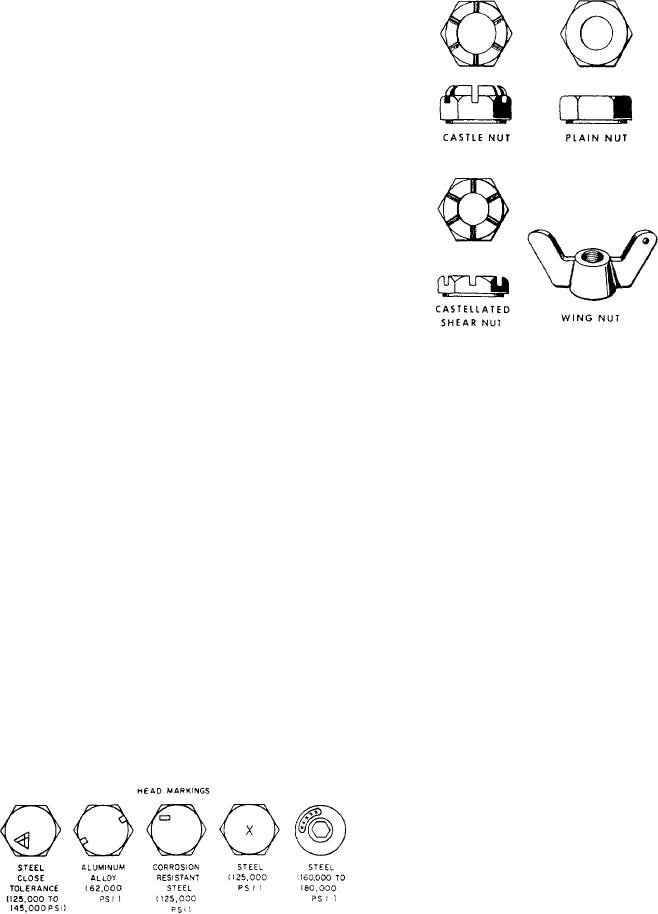
replacement are head thickness and width. If the
head is too thin or too narrow, it might not be
strong enough to bear the load imposed on it. If
the head is too thick or too wide, it might extend
so far that it interferes with the movement of
adjacent parts.
AN bolts come in three head styles--hex head,
clevis, and eyebolt. NAS bolts are available in
countersunk, internal wrenching, and hex head
styles. MS bolts come in internal wrenching and
hex head styles. Head markings indicate the
material of which standard bolts are made. Head
markings may indicate if the bolt is classified as
a close-tolerance bolt. See figure 2-17. Additional
information, such as bolt diameter, bolt length,
and grip length, may be obtained from the bolt
part number. Refer to the Structural Hardware
Manual, NAVAIR 01-1A-8, for complete identifi-
cation of threaded fasteners.
Figure 2-18.-Non-self-locking nuts.
Nuts
Aircraft nuts may be divided into two general
only. They must not be used in installations where
groups: non-self-locking and self-locking nuts.
tension stresses are encountered.
Plain hex nuts have limited use on aircraft
Non-self-locking nuts are those that must be
safetied by external locking devices, such as cotter
structures. They require an auxiliary locking
pins, safety wire, or locknuts. The locking feature
device such as a check nut or a lock washer.
Use wing nuts where the desired tightness can
is an integral part of self-locking nuts.
be obtained by the fingers and where the assembly
NON-SELF-LOCKING NUTS.-- The most
is frequently removed. Wing nuts are commonly
common of the non-self-locking nuts are the castle
used on battery connections.
nut, the plain hex nut, the castellated shear nut,
SELF-LOCKING NUTS.-- Self-locking nuts
and the wing nut. Figure 2-18 shows these non-
provide tight connections that will not loosen
self-locking nuts.
Castle nuts are used with drilled-shank AN
under vibrations. Self-locking nuts approved for
hex-head bolts, clevis bolts, or studs. They are
use on aircraft must meet critical specifications.
These specifications pertain to strength, corrosion
designed to accept a cotter pin or lockwire for
resistance, and heat-resistant temperatures. Use
safetying.
new self-locking nuts each time components are
Castellated shear nuts are used on such parts
as drilled clevis bolts and threaded taper pins.
installed in critical areas throughout the entire air-
They are normally subjected to shearing stress
craft. Self-locking nuts are found on all flight,
engine, and fuel control linkage and attachments.
There are two general types of self-locking nuts.
They are the all-metal nuts and the metal nuts with
a nonmetallic insert to provide the locking action.
The elastic stop nut is constructed with a
nonmetallic (nylon) insert, which is designed to
lock the nut in place. The insert is unthreaded and
has a smaller diameter than the inside diameter
of the nut. Its use is limited to engine cold
sections, s i n c e high heat could melt the
nonmetallic insert.
Self-locking nuts are generally suitable for
reuse in noncritical applications provided the
Figure 2-17.-Bolt head markings.
2-14

